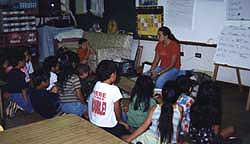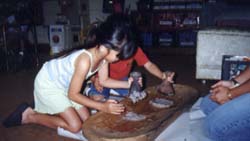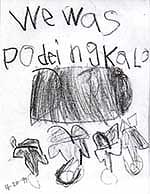![]()

Poi Pounding Lesson
Written by Pohai
Kukea
(Done
with Kindergarten students)
Objectives
- Students will be able to identify the part of the kalo plant that is used to make poi.
- Students will be able to summarize the steps taken to make poi.
- Students will be able to appreciate the amount of effort it takes to make poi the way ancient Hawaiians did.
- Students will be able to perform the chant, "Huli i ke kalo" and the motions that go with it.
Standards
1. Students use the tools and methodology of social scientists to explain and interpret ideas and events.
- Examine artifacts of cultures to make informed decisions and/or judgments based on evidence found.
2. Students understand culture as a system of beliefs, knowledge and practices shared by a group.
- Explain how different cultures, beliefs and practices are expressed in language, stories, music, art and celebrations.
Teaching Procedures and Activities
1. Focusing event - wrap the poi pounder with cloth or put it in a bag. Have the students guess what is in the bag. Give the students hints and the opportunity to ask questions and keep guessing until they figure it out. Introduce the Hawaiian term for a poi pounder and why it has that name.
| 2.
Ask the students to remind about the parts of the kalo plant, using
different intellegences. Have them identify the different parts of
the plant, while I point to them. Then have them make their bodies
in the shape of the different parts of the plant and name them.
3. Start demonstrating how to prepare and pound kalo - Peel with the opihi shell, explain about having to cook it, show how you add water and pound at the same time. Some questions to spur discussion:
4. While I am demonstrating, teach the students the different verses of the "Huki i ke kalo" and have them chant it while I demonstrate. 5. After I demonstrate, the students will break out into three centers. The first center is a tasting center where they will have the opportunity to taste the different things that are made with the kalo plant (laulau, kulolo, poi). The second center will be for the students to try to pound poi, giving them a hands-on experience. The third center will be for the students to write in their journals about the experiences. Students will also be given the opportunity to go back and write in their journals after they have rotated through the different centers. 6. Review the chant again after the activity. Have a class discussion about what we learned. |
 |
| Talking
to students about what they already know about kalo. |
|
 |
|
| Demonstrating
how to pound kalo. |
|
 |
|
| Students
making their own pa'i 'ai |
|
 |
|
| Student
journal entry ("We was pounding kalo") |
|
 |
|
| Another example of student work. |
Assessment
- Student identification of the parts of the kalo plant, using the actual plant.
- Student journal writing about how to make poi.
- Discussion with students about how poi is made today, as opposed to how it was made by ancient Hawaiians.
- Student performance of chant
Copyright 2000-2001 All Rights Reserved